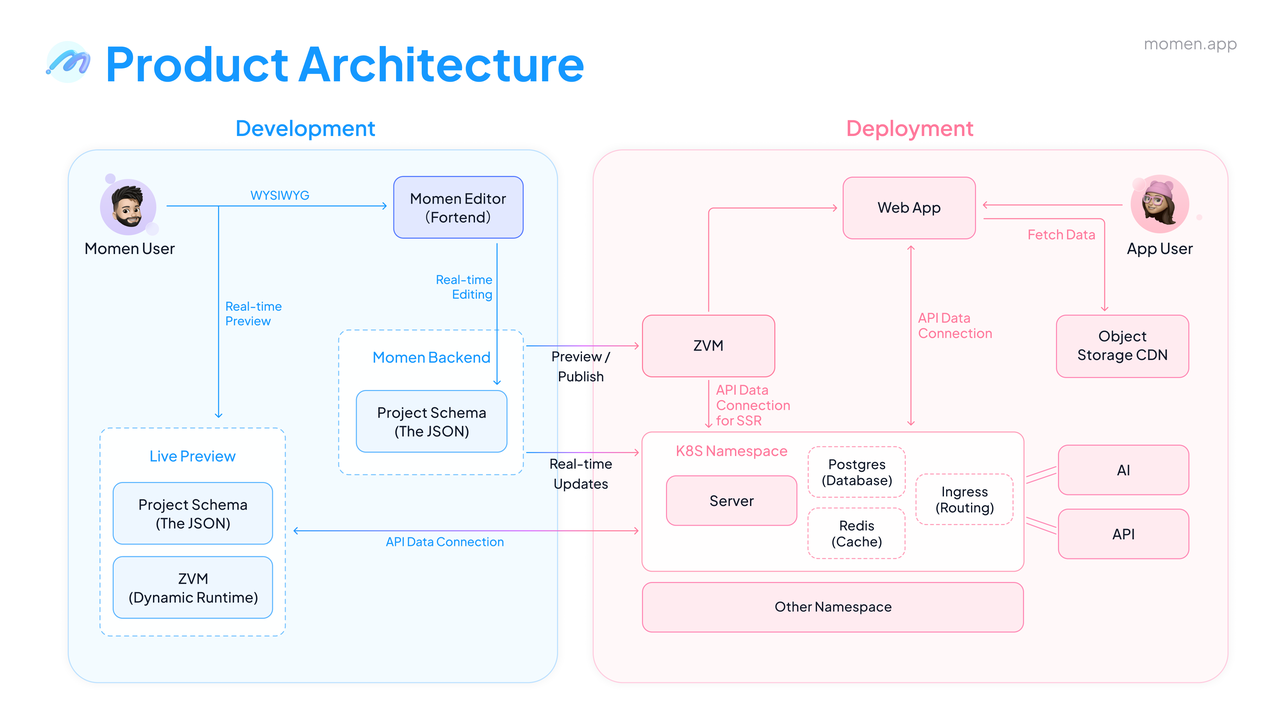Beyond Prototypes: Can No-Code Handle Growth?

Can no-code platforms scale beyond prototypes? This question is crucial as you explore the potential of the no-code development. No-code platforms have demonstrated remarkable efficiency in rapid prototyping and MVP development, with studies indicating up to 80% reduction in development costs and a 90% decrease in development time. However, its ability of suppporting enterprise-scale has been questioned, especially in terms of backend scalability and server performance in high-load scenarios. While many no-code platforms require additional infrastructure for backend scaling, contemporary solutions have evolved to include integrated backend capabilities, automated server management, and security maintenance features. These advancements enable organizations to transition from proof-of-concept to production-ready applications while maintaining performance and reliability standards.
Understanding Scalability in No-Code

Definition of Scalability
What scalability means in the context of no-code
In the realm of no-code development, scalability refers to the ability of an application to handle increased loads, whether in terms of user traffic or data processing, without compromising performance. As you build applications using no-code platforms, understanding scalability becomes crucial. While no-code platforms have revolutionized rapid application development, achieving enterprise-scale functionality requires careful consideration of backend architecture and performance characteristics.
Differences between scaling traditional and no-code applications
Scaling traditional applications often involves complex coding and infrastructure management. You might need to write custom code to optimize performance or integrate with external systems. In contrast, no-code development simplifies this process. However, not all no-code platforms are created equal. Some, like Bubble, may require external tools for backend scaling, as their built-in capabilities might not suffice for enterprise-level demands.
Importance of Scalability
Why scalability is crucial for business growth
Scalability is a cornerstone of business growth. As your application attracts more users, you must ensure it can handle the increased load without degrading performance. Low-code and no-code platforms offer a unique advantage here. They allow you to iterate quickly and adapt to changing demands. By planning for scalability from the outset, you position your business to capitalize on opportunities without being hindered by technical limitations.
Potential risks of ignoring scalability
Ignoring scalability can lead to significant risks. Applications that cannot scale may experience slowdowns, crashes, or data loss as user numbers increase. This can damage your reputation and result in lost revenue. Low-code and no-code platforms must evolve to address these challenges, especially for large enterprise-grade systems.
Key Factors Influencing No-Code Scalability
When building applications on no-code platforms, understanding the factors that influence scalability is crucial for long-term success.

Platform Capabilities
Limitations and strengths of no-code platforms
The foundation of any scalable no-code application lies in its backend architecture. Modern platforms offer varying levels of backend capabilities:
PostgreSQL-based systems
Cloud-native databases
Hybrid solutions
When choosing a no-code platform, understanding its backend architecture and database management approach is crucial.
For example, Momen uses PostgreSQL as its foundation, providing a thin wrapper that exposes most of PostgreSQL's native functionality. This approach enables:
True 1:N relations (one-to-many relationships between data)
ACID guarantees (ensuring data reliability and consistency)
Atomic operations (all-or-nothing transactions)
How platform choice affects scalability
Your platform choice directly impacts your application's scalability potential. Here's what to look for in a scalable platform:
• Efficient Resource Management
Automated resource allocation
Optimized database queries
Smart caching mechanisms
• Scaling Capabilities
Horizontal and vertical scaling options
Load balancing features
Automated performance optimization
• Monitoring and Management
Real-time performance metrics
Resource usage analytics
Proactive scaling alerts
Momen demonstrates these capabilities through:
Processing capacity of 5,000 rows per second
Cost-effective growth options (single-tenant or bring-your-own-cloud)
Scalable infrastructure supporting 3,200-6,400 requests per second
Automated CI/CD (Continuous Integration/Continuous Deployment) for reliable updates

Application Complexity
Impact of application design on scalability
The design of your application plays a significant role in its scalability. Complex applications require careful planning to ensure they can handle increased user traffic and data processing demands. A platform with potential to handle scalability can save you both time and cost in tackling technical issues, making you focus on your business growth.
Momen's approach to handling complex operations focuses on comprehensive security and efficient data management. The platform extends its attribute-based-access-control (ABAC) system to cover third-party APIs, backend workflows (Actionflows), and AI interactions, providing thorough security control.
Database query optimization is streamlined through Momen's GraphQL implementation. For example, you can fetch a list of posts with specific fields (title, creation time) along with related data (last 5 viewers, author details, comment count) in a single operation, optimizing both performance and resource usage.
Managing complexity in no-code applications
Effective management of complexity requires a strategic approach to application design. Usually it requires:
Strategic planning for future growth
Efficient use of platform features
Optimization of data relationships
Regular performance monitoring
By planning for scalability upfront, you ensure that your no-code solution can evolve with your business. This proactive approach minimizes risks and maximizes the potential for growth, allowing you to focus on expanding your business without being hindered by technical limitations.

Optimizing Performance
Techniques for improving application performance
To scale a no-code app effectively, you must focus on optimizing performance. Start by analyzing your application's architecture. Simplify complex workflows and reduce unnecessary processes. This streamlining enhances speed and efficiency. Use caching strategies to store frequently accessed data temporarily. This reduces server load and improves response times. Regularly update your application to incorporate the latest performance enhancements.
Tools and resources for performance optimization
No-code tools offer various resources to help you monitor performance and optimize your application. Utilize built-in analytics to track performance metrics. These insights guide you in identifying bottlenecks and areas for improvement. Additionally, third-party tools can enhance optimization efforts. Integrate services that specialize in performance monitoring and load testing to ensure your app remains responsive as it scales.
Leveraging Integrations
Using third-party integrations to enhance functionality

Effective integration strategies include:
Careful selection of third-party services
Automation of routine tasks
Streamlined data flow between systems
Regular evaluation of integration performance
Balancing integrations with platform capabilities
While integrations offer significant benefits, balancing them with your platform's capabilities is essential. Over-reliance on external tools can lead to complexity and potential performance issues. Evaluate each integration's impact on your app's scalability. Ensure that your chosen no-code platforms can support these integrations without compromising performance. Momen's design considers applications with one million daily active users, providing the control needed to manage complexity effectively.
Future of No-Code in Scaling Your Business

Challenges Faced
Common obstacles in scaling no-code applications
Scaling a no-code app presents unique challenges. Some platforms, like Bubble, may require external tools for backend scaling due to limited built-in capabilities. This reliance on additional resources can complicate the development process and hinder scalability. Moreover, managing application complexity becomes crucial as your user base grows. Without careful planning, performance issues such as slowdowns or crashes may arise, impacting user experience and business reputation.
Lessons learned from overcoming these challenges
Choose the Right Platform: Selecting a platform with comprehensive scalability features is essential. Momen, for instance, eliminates common challenges like server scaling and security patching, allowing you to focus on growth.
Plan for Complexity: Anticipate the complexities of scaling a no-code app. Use platforms that offer robust backend support to manage extensive data loads and user traffic.
Leverage Integrations Wisely: While integrations enhance functionality, balance them with your platform's capabilities to avoid performance issues.
Continuous Monitoring: Regularly monitor your application's performance. Utilize tools and analytics to identify bottlenecks and optimize efficiency.
By learning from these real-world examples, you can navigate the challenges of scaling a no-code app effectively.
Emerging Trends
The no-code landscape continues to evolve, bringing forth innovations that redefine how you approach application development. These advancements empower you to create complex applications without traditional coding barriers.
Gartner, a leader in market analysis, emphasizes the transformative potential of no-code technology. They highlight how no-code platforms harness the collective knowledge of your internal team, enabling them to develop applications tailored to specific business needs. This democratization of software development empowers non-technical users to create solutions that drive business growth.
As no-code technology advances, its role in scaling your business becomes increasingly significant. Experts predict that no-code platforms will continue to simplify the development process, making it accessible to a broader audience. This accessibility will drive innovation and enable businesses to adapt quickly to changing market demands. As no-code platforms evolve, they will offer even more sophisticated tools for managing complexity and scalability, positioning your business for success in a competitive landscape.
How businesses are preparing for no-code growth
Businesses are increasingly adopting no-code platforms to support their growth strategies. They recognize the potential of these tools to streamline operations and enhance scalability.
To prepare for no-code growth, businesses focus on selecting platforms that offer comprehensive scalability features, enabling business manage complexity and achieve sustainable growth.
FAQ
What does scalability mean in the context of no-code platforms?
Scalability in no-code platforms refers to an application's ability to handle increased workloads and user loads without compromising performance. As your business grows, your no-code solution should evolve with it. Planning for scalability upfront ensures that your application can adapt to changing demands without causing disruptions or incurring additional costs.
Can no-code platforms handle complex applications?
While no-code platforms can support various applications, they may face limitations with highly complex or resource-intensive projects. Some platforms, like Bubble, might require external tools for backend scaling due to limited built-in capabilities. Choosing a platform like Momen, which offers robust backend support and automated CI/CD processes, ensures your application can handle complexity and scale effectively.
How do I ensure my no-code app can scale?
To ensure scalability, start by selecting a platform with comprehensive scalability features. Momen, for example, eliminates common challenges like server scaling and security patching, allowing you to focus on growth. Additionally, optimize your database, implement caching strategies, and leverage third-party integrations wisely to enhance functionality without compromising performance.
Are there any limitations with no-code platforms?
Yes, no-code platforms have limitations, such as restricted customization options and potential performance issues for complex applications. They may not support advanced integrations or custom business logic required for specific use cases, making them less suitable for large enterprises or projects with unique requirements. However, platforms like Momen provide powerful backend capabilities, enabling you to manage complexity and achieve seamless scalability.
How do low-code platforms compare to no-code platforms in terms of scalability?
Low-code platforms offer more flexibility and customization options than no-code platforms, making them better suited for complex or large-scale projects. They allow developers to write custom code when necessary, providing greater control over scalability and performance. However, no-code platforms like Momen are designed to handle extensive data loads and user traffic, ensuring your application can scale effectively as your business grows.
What are the key factors influencing no-code scalability?
Several factors influence no-code scalability, including platform capabilities, application complexity, and resource management. Platforms that minimize resource usage while maximizing efficiency stand at the forefront of scalability. Momen's design, which considers applications with one million daily active users, exemplifies how no-code development can support substantial growth.
How can I manage complexity in no-code applications?
Managing complexity in no-code applications involves leveraging the platform's features to optimize performance and scalability. Momen supports extensive data loads and user traffic, ensuring your application can scale with your business. By using third-party integrations and scalable backend solutions, you can enhance your application's functionality without compromising performance.
What are some real-world examples of scaling a no-code app?
Companies like Swapstack and Closify have successfully scaled their operations using no-code development. These businesses rapidly built and iterated on their platforms, demonstrating that with the right approach, no-code platforms can support significant growth and scalability. Key takeaways from their experiences include rapid iteration, cost efficiency, and focusing on core business strategies.
How do I prepare for no-code growth?
To prepare for no-code growth, focus on selecting platforms that offer comprehensive scalability features. Momen stands out by providing a seamless transition from a demo app to a world-class solution, with server resources that can be scaled on demand. This level of control and capability is essential for managing complexity and achieving sustainable growth.
See Also
Creating An Affordable No-Code Platform For Web Development
Understanding The Impact Of No-Code Development On Companies
Transforming Legacy Businesses: The Power Of No-Code ERP
